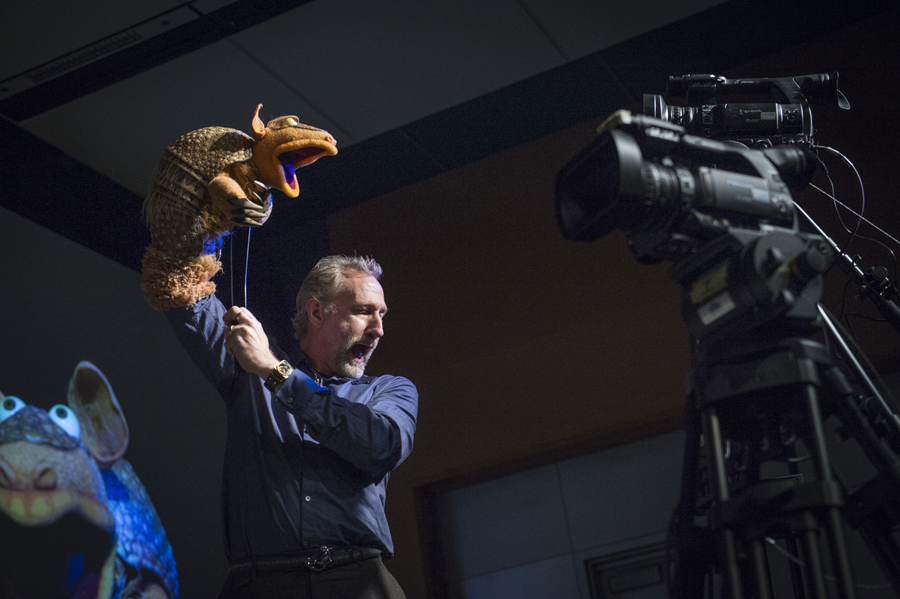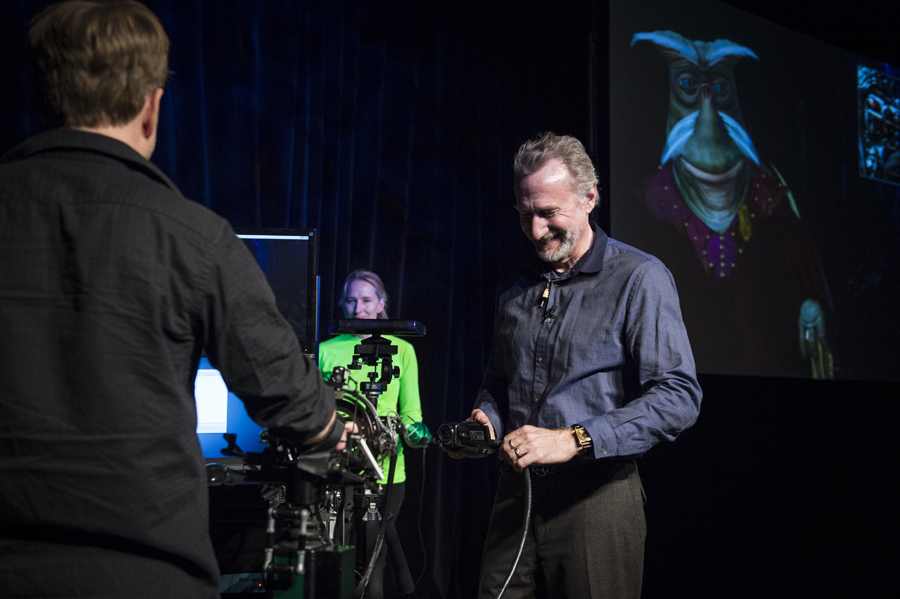
Brian Henson demos how to make a puppet lip sync perfectly, and turn to camera to create a personal connection with the viewer. Photo: James Duncan Davidson
“Spontaneity is the most delicious part,” says Brian Henson in a master class at TED2014, hosted by Syfy. “There’s something about letting a moment happen. Your best-laid plans cannot exceed what happens spontaneously.”
Henson, a master puppeteer and the chair of The Jim Henson Company, says that a love of spontaneity deeply infused his father’s work, and still guides what the company does today. In a fascinating lecture before a small group of TEDsters, Henson demonstrates how the company has kept spontaneity alive as technology has advanced.
Henson begins by showing a puppet, an adorable armadillo, revealing how the classic form allows a puppeteer to speak and react in a way that makes a character feel real. Puppets form the core of what The Jim Henson Company does, but in the ’80s they expanded to “creatures,” characters that feel so lifelike that “if you cut them, they bleed.” For Dark Crystal and Labyrinth, The Jim Henson Company created some truly incredible creatures (hello, Hoggle), but it required the coordination of many puppeteers — one working the sightlines, one working blinks, one working eyebrows, etc. — which required a ton of rehearsal time. Spontaneity suffered.
The company soon created the “performance control system,” which allows one puppeteer to do a character’s voice and operate all the parts of his face. The system includes a very space-age joystick and a glove that lets one person give 32 facial inputs, while a second and third control the body. This system, used for Teenage Mutant Ninja Turtles and the TV show Dinosaurs, is important because it brought back spontaneity.

Henson and two puppeteers show how a computer-generated character can be performed. One puppeteer uses the “professional control system” for the voice and face. And a second puppeteer in a green suit controls the body movement. Together, they generate the character you see on the screen. Photo: James Duncan Davidson
The company has found new ways to allow for spontaneity even with the move toward CGI, using the performance control system with new software that creates high-resolution animation. It takes the performers’ on-the-fly motions and words, and renders them ultra-precisely on screen. From here, the company is headed toward a hybrid approach, using animatronic creatures, which better inhabit a space, and computer-generated faces, which allow for incredible precision, in tandem. This is exactly what the company did for the creatures in Where the Wild Things Are.
Henson shows us this evolution for a purpose — because, next week, the television series Jim Henson’s Creature Shop Challenge premieres on SyFy. A la Project Runway and Top Chef, the show brings together 10 designers who’ll compete for $100,000 and a contract working for Jim Henson’s Creature Shop. The challenges will show the complex process of creating creatures, from coming up with the idea, to fabricating the form, to mechanizing it so it moves in fluid ways. The show will peel back the curtain behind how creatures are created, and how puppeteers bring them to life.
“Because if you can’t perform it, it’s not going to be as much fun,” says Henson. “That’s the Jim Henson zaniness.”
Watch Jim Henson’s Creature Shop Challenge on Syfy, starting March 25 at 10/9c.
Comments (7)
Pingback: 14 Blog Notes – NEW MEDIA DESIGN
Pingback: Weekly Puppetry News Round-Up: Muppets Most Wanted Edition | PuppetVision
Pingback: Brian Henson talks about Animatronics at TED « Technology with Mr.Uu
Pingback: TED | Jeff Henschel